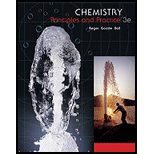
(a)
Interpretation:
The concentration of all species after the attainment of equilibrium in the following reaction has to be determined.
Concept Introduction:
The condition of equilibrium is a state of balance of processes that runs in opposite directions. At equilibrium, the formation of product from reactant balances the formation of reactant from product. Also, the change in concentration of reaction and product seems to be negligible at equilibrium state.
The general equilibrium reaction is as follows:
Here,
(a)
Answer to Problem 14.88QE
The concentration of
Explanation of Solution
The given reaction occurs as follows:
The concentration of
The ICE table for the above reaction is as follows:
The concentration of
The concentration of
The value of
Therefore the equilibrium concentration of
(b)
Interpretation:
The value of
Concept Introduction:
The general equilibrium reaction is as follows:
Here,
The expression of the equilibrium constant for the above reaction is as follows:
Here,
(b)
Answer to Problem 14.88QE
The value of
Explanation of Solution
The given reaction occurs as follows:
The expression of
Substitute
(c)
Interpretation:
The value of
Concept Introduction:
The relation of equilibrium constant
Here,
The formula to calculate the value of
The value of
(c)
Answer to Problem 14.88QE
The value of
Explanation of Solution
The given reaction occurs as follows:
Substitute 2 for the total number of moles of gas on product side and 1 for the total number of moles of gas on reactant side in equation (3).
The formula to convert degree Celsius to Kelvin is as follows:
Substitute
Substitute 1 for
Want to see more full solutions like this?
Chapter 14 Solutions
Chemistry
- Show that the complete chemical equation, the total ionic equation, and the net ionic equation for the reaction represented by the equation KI(aq)+I2(aq)KI3(aq) give the same expression for the reaction quotient. KI3 is composed of the ions K+ and I3-.arrow_forwardWrite an equation for an equilibrium system that would lead to the following expressions (ac) for K. (a) K=(Pco)2 (PH2)5(PC2H6)(PH2O)2 (b) K=(PNH3)4 (PO2)5(PNO)4 (PH2O)6 (c) K=[ ClO3 ]2 [ Mn2+ ]2(Pcl2)[ MNO4 ]2 [ H+ ]4 ; liquid water is a productarrow_forwardWrite the expression for the equilibrium constant and calculate the partial pressure of CO2(g), given that Kp is 0.25 (at 427 C) for NaHCO3(s) NaOH(s) + CO2(g)arrow_forward
- Consider 0.200 mol phosphorus pentachloride sealed in a 2.0-L container at 620 K. The equilibrium constant, Kc, is 0.60 for PCl5(g) PCl3(g) + Cl2(g) Calculate the concentrations of all species after equilibrium has been reached.arrow_forwardWrite the equilibrium constant expression for each reaction in terms of activities, simplifying where appropriate. a C(s)+O2(g)CO2(g) b P4(s)+5O2(g)P4O10(s) c 2HNO2(g)+3Cl2(g)2NCl3(g)+H2(g)+2O2(g)arrow_forwardFor the reaction N2(g)+3H2(g)2NH3(g) show that Kc = Kp(RT)2 Do not use the formula Kp = Kc(RT)5n given in the text. Start from the fact that Pi = [i]RT, where Pi is the partial pressure of substance i and [i] is its molar concentration. Substitute into Kc.arrow_forward
 Chemistry: Principles and PracticeChemistryISBN:9780534420123Author:Daniel L. Reger, Scott R. Goode, David W. Ball, Edward MercerPublisher:Cengage Learning
Chemistry: Principles and PracticeChemistryISBN:9780534420123Author:Daniel L. Reger, Scott R. Goode, David W. Ball, Edward MercerPublisher:Cengage Learning General Chemistry - Standalone book (MindTap Cour...ChemistryISBN:9781305580343Author:Steven D. Gammon, Ebbing, Darrell Ebbing, Steven D., Darrell; Gammon, Darrell Ebbing; Steven D. Gammon, Darrell D.; Gammon, Ebbing; Steven D. Gammon; DarrellPublisher:Cengage Learning
General Chemistry - Standalone book (MindTap Cour...ChemistryISBN:9781305580343Author:Steven D. Gammon, Ebbing, Darrell Ebbing, Steven D., Darrell; Gammon, Darrell Ebbing; Steven D. Gammon, Darrell D.; Gammon, Ebbing; Steven D. Gammon; DarrellPublisher:Cengage Learning Chemistry: Principles and ReactionsChemistryISBN:9781305079373Author:William L. Masterton, Cecile N. HurleyPublisher:Cengage Learning
Chemistry: Principles and ReactionsChemistryISBN:9781305079373Author:William L. Masterton, Cecile N. HurleyPublisher:Cengage Learning Chemistry by OpenStax (2015-05-04)ChemistryISBN:9781938168390Author:Klaus Theopold, Richard H Langley, Paul Flowers, William R. Robinson, Mark BlaserPublisher:OpenStax
Chemistry by OpenStax (2015-05-04)ChemistryISBN:9781938168390Author:Klaus Theopold, Richard H Langley, Paul Flowers, William R. Robinson, Mark BlaserPublisher:OpenStax Chemistry: The Molecular ScienceChemistryISBN:9781285199047Author:John W. Moore, Conrad L. StanitskiPublisher:Cengage Learning
Chemistry: The Molecular ScienceChemistryISBN:9781285199047Author:John W. Moore, Conrad L. StanitskiPublisher:Cengage Learning Chemistry for Engineering StudentsChemistryISBN:9781337398909Author:Lawrence S. Brown, Tom HolmePublisher:Cengage Learning
Chemistry for Engineering StudentsChemistryISBN:9781337398909Author:Lawrence S. Brown, Tom HolmePublisher:Cengage Learning





